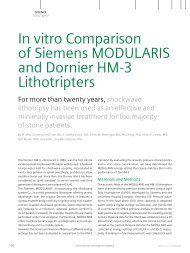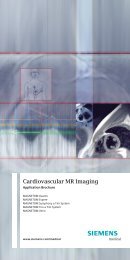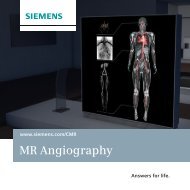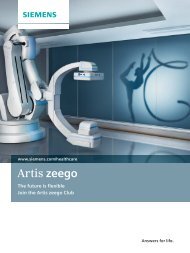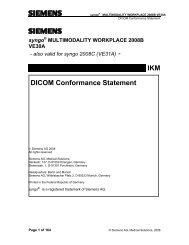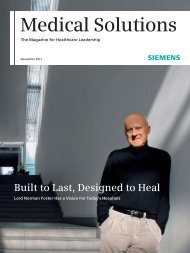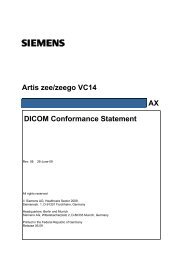Outstanding DWI diagnostic performance with syngo RESOLVE 2.90 ...
Outstanding DWI diagnostic performance with syngo RESOLVE 2.90 ...
Outstanding DWI diagnostic performance with syngo RESOLVE 2.90 ...
You also want an ePaper? Increase the reach of your titles
YUMPU automatically turns print PDFs into web optimized ePapers that Google loves.
Leading.<br />
With<br />
MAGNETOM.<br />
www.siemens.com/<strong>RESOLVE</strong><br />
<strong>Outstanding</strong> <strong>DWI</strong> <strong>diagnostic</strong><br />
<strong>performance</strong> <strong>with</strong> <strong>syngo</strong> <strong>RESOLVE</strong><br />
Answers for life.
Diffusion-<br />
Weighted Imaging<br />
The diffusion rate of water molecules in different tissues<br />
correlates <strong>with</strong> their physiological state, and may be<br />
altered in disease.<br />
Diffusion-weighted imaging (<strong>DWI</strong>) enables visualization<br />
and measurement of abnormal diffusivity, revealing<br />
lesions which may go unnoticed <strong>with</strong> conventional<br />
anatomical MR or CT imaging alone. The practical clinical<br />
value of <strong>DWI</strong> is well established. Despite some challenges<br />
in certain body regions, particularly at higher field<br />
strengths, <strong>DWI</strong> is now broadly used in clinical routine.<br />
<strong>syngo</strong> <strong>RESOLVE</strong><br />
<strong>syngo</strong> <strong>RESOLVE</strong> is a revolutionary new approach for<br />
obtaining high quality <strong>DWI</strong> images even in body regions<br />
strongly affected by susceptibility artifacts.<br />
The clinical impact of <strong>syngo</strong> <strong>RESOLVE</strong> has been shown<br />
in a variety of examinations, including the brain,<br />
skull base, spine, breast, prostate, pelvis and rectum.<br />
<strong>syngo</strong> <strong>RESOLVE</strong> can be particularly useful in the<br />
evaluation of smaller lesions especially in regions<br />
strongly affected by susceptibility artifacts.<br />
Compared to alternative methods (see glossary, p.17),<br />
<strong>syngo</strong> <strong>RESOLVE</strong> brings the best balance of imaging<br />
speed and quality.<br />
2<br />
MAGNETOM Skyra
<strong>syngo</strong> <strong>RESOLVE</strong> – readout segmentation of long variable echo-trains<br />
Experience a higher level of <strong>diagnostic</strong> confidence <strong>with</strong> sharp,<br />
high-resolution diffusion-weighted images largely free of geometric distortions.<br />
Applications<br />
• Applicable in a variety of challenging body regions<br />
including brain, skull-base, spine, breast, pelvis and<br />
prostate<br />
Advantages<br />
• High-quality, high-resolution <strong>DWI</strong> and DTI<br />
• Reduced susceptibility and blurring artifacts<br />
• Insensitivity to motion-induced phase errors<br />
• Reduced SAR in comparison to TSE-based methods<br />
Conventional <strong>DWI</strong><br />
<strong>syngo</strong> <strong>RESOLVE</strong><br />
Nagoya University School of Medicine, Nagoya, Japan<br />
MAGNETOM Verio<br />
Technical specifications<br />
• Readout-segmented, multi-shot EPI for reduced<br />
TE and encoding time<br />
• Motion correction <strong>with</strong> 2D phase navigator and<br />
real-time image reacquisition for unusable data<br />
High Resolution Diffusion-Weighted Imaging Using<br />
Readout-Segmented Echo-Planar Imaging, Parallel<br />
Imaging and a Two-Dimensional Navigator-Based<br />
Reacquisition<br />
Phase-encoding<br />
direction (ky)<br />
David A. Porter, 1* and Robin M. Heidemann2<br />
Magnetic Resonance in Medicine 62:468–475 (2009)<br />
Single-shot echo-planar imaging (EPI) is well established as the of susceptibility artifacts and increased blurring due to a<br />
method of choice for clinical, diffusion-weighted imaging <strong>with</strong> shorter T* 2 relaxation time. The effect of field strength is a<br />
MRI Magn because ofReson its low sensitivity Med, to the motion-induced 62(2), phase 468-475,<br />
significant consideration<br />
2009because of the increasing amount<br />
errors that occur during diffusion sensitization of the MR signal. of routine clinical imaging that is being performed at field<br />
However, the method is prone to artifacts due to susceptibility<br />
strengths of 3 Tesla (T) and above.<br />
changes at tissue interfaces and has a limited spatial resolution.<br />
The introduction of parallel imaging techniques, such as<br />
Motion during the diffusion-sensitizing gradients leads<br />
to a spatially dependent phase variation that is different<br />
GRAPPA (GeneRalized Autocalibrating Partially Parallel k-space Acquisitions),<br />
has reduced these problems, but there are still signif-<br />
from one excitation to the next. This produces a very high<br />
trajectory<br />
icant limitations, particularly at higher field strengths, such as 3 level of artifact if standard multishot imaging techniques<br />
Tesla (T), which are increasingly being used for routine clinical<br />
imaging. This study describes how the combination of readoutsegmented<br />
EPI and parallel imaging can be used to address the effect of cerebrospinal fluid (CSF) pulsation on the<br />
variation is a linear function of position (9,10). However,<br />
these issues by generating high-resolution, diffusion-weighted brain is to induce deformations, which do not conform to<br />
images at 1.5T and 3T <strong>with</strong> a significant reduction in susceptibility<br />
artifact compared <strong>with</strong> the single-shot case. The techation<br />
has a more general nonlinear behavior in two dimen-<br />
a rigid-body model. In this case, the resulting phase varinique<br />
uses data from a 2D navigator acquisition to perform a<br />
sions (11).<br />
nonlinear phase correction and to control the real-time reacquisition<br />
of unusable data that cannot be corrected. Measure-<br />
To compensate for this phase variation, navigator echo<br />
acquisitions were introduced into multishot sequences to<br />
ments on healthy volunteers demonstrate that this approach<br />
provides a robust correction for motion-induced phase artifact monitor the shot-to-shot phase changes and apply a suitable<br />
correction to the data (9,10). Initial implementations,<br />
and allows scan times that are suitable for routine clinical<br />
application. Magn Reson Med 62:468–475, 2009. © 2009 based on spin-echo sequences, used an additional echo to<br />
Wiley-Liss, Inc.<br />
reacquire the central line of k-space at each excitation and<br />
Key words: readout-segmented EPI; parallel imaging; GRAPPA; applied a linear phase correction along the readout direction.<br />
Subsequently, the technique was extended to use 2D<br />
2D navigator; diffusion weighted imaging<br />
navigators to perform linear phase correction in both readout<br />
and phase-encoding directions in interleaved seg-<br />
The application of diffusion-weighted imaging in clinical<br />
studies is well established, particularly in the evaluation mented EPI acquisitions (12,13).<br />
of acute stroke (1–3). These studies typically rely on single-shot<br />
diffusion-weighted echo-planar imaging (EPI; 4) phase-correction techniques have made it possible to ap-<br />
More recently, alternative sequence types and modified<br />
which provides reliable clinical images free from motioninduced<br />
artifact. However, as is well documented, single-<br />
This is an essential requirement to achieve a robust corply<br />
a nonlinear, 2D phase-correction using navigator data.<br />
shot EPI is sensitive to susceptibility artifacts at tissue rection for the phase errors that occur in diffusionweighted<br />
imaging of the brain. This type of correction<br />
interfaces and suffers from a limitation to the maximum<br />
resolution that can be achieved. Although the introduction typically involves transforming to the image domain and<br />
of parallel imaging techniques to single-shot acquisition performing a complex multiplication of the imaging signals<br />
<strong>with</strong> data derived from the corresponding 2D naviga-<br />
methods like EPI (5–8) has reduced these effects, there are<br />
still significant residual problems. This is particularly true tor. It is also possible to apply an equivalent correction<br />
at higher field strengths where there is an increased level using a direct deconvolution of the k-space data (11). As<br />
only a subset of k-space points are sampled at each excitation,<br />
the image domain data used in this process do not<br />
1 Siemens AG, Healthcare Sector, Erlangen, Germany.<br />
provide an accurate representation of the actual 2D spatial<br />
2 Max Planck Institute for Human Cognitive and Brain Sciences, Department of variation of signal. In particular, k-space sampling strategies<br />
that do not fulfill the Nyquist condition for the re-<br />
Neurophysics, Leipzig, Germany.<br />
*Correspondence to: David A. Porter, Siemens AG, Healthcare Sector, MED<br />
quired field of view (FOV) at each shot result in aliasing,<br />
MR PLM AW Neurology, Allee am Roethelheimpark 2, 91052 Erlangen, Germany.<br />
E-mail: david.a.porter@siemens.com<br />
which complicates the image-domain 2D phase correction.<br />
Received 25 August 2008; revised 19 February 2009; accepted 25 February Promising results have been shown using iterative phase<br />
2009.<br />
correction algorithms to address the problem of aliasing in<br />
DOI 10.1002/mrm.22024<br />
Published online 15 May 2009 in Wiley InterScience (www.interscience. several sequences, including true FISP (11), spiral imaging<br />
wiley.com).<br />
(14), and interleaved EPI (15). However, these techniques<br />
© 2009 Wiley-Liss, Inc. 468<br />
1 st shot 2 nd are<br />
shot 3 rd used. In the case of<br />
shot 4 th rigid body motion, this<br />
shot 5 th phase<br />
shot<br />
readout<br />
direction (kx)<br />
3
Neuroimaging<br />
Hippocampal lesion<br />
Conventional <strong>DWI</strong><br />
<strong>syngo</strong> <strong>RESOLVE</strong><br />
T2 TSE, GRAPPA 2, matrix 576, SL 2 mm b1000 and ADC map, GRAPPA 2,<br />
matrix 160, TA 0.03 s/slice<br />
b1000 and ADC map, GRAPPA 2,<br />
matrix 384, TA 0.05 s/slice<br />
Ebara Hospital, Tokyo, Japan<br />
MAGNETOM Trio, A Tim System<br />
4
Brain tumor<br />
T1 3D SPACE, GRAPPA 2,<br />
post-contrast<br />
<strong>syngo</strong> <strong>RESOLVE</strong>, b0, b1000 and ADC map, GRAPPA 2, matrix 188, TA 5:25 min<br />
3D SPACE DIR, GRAPPA 2<br />
<strong>syngo</strong> <strong>RESOLVE</strong>, b0, b1000 and ADC map, GRAPPA 2, matrix 210, TA 5:18 min<br />
IRM Francheville, Perigueux, France<br />
MAGNETOM Aera<br />
5
Conventional <strong>DWI</strong><br />
<strong>syngo</strong> <strong>RESOLVE</strong><br />
Spine<br />
Post accident,<br />
TH6 and TH12 fracture<br />
T2 TSE, GRAPPA 2,<br />
matrix 384<br />
Singapore General Hospital, Singapore<br />
MAGNETOM Avanto<br />
b650, ADC map and T1 TSE fused<br />
<strong>with</strong> b0 image, GRAPPA 2, matrix 128,<br />
TA 0.05 s/slice<br />
b650, ADC map and T1 TSE fused<br />
<strong>with</strong> b0 image, GRAPPA 2, matrix 150,<br />
TA 0.02 s/slice<br />
6
“<strong>syngo</strong> <strong>RESOLVE</strong> is a<br />
useful sequence for<br />
acquiring high-quality<br />
diffusion-weighted<br />
images thanks to the<br />
reduction of susceptibility<br />
distortion,<br />
reduction of T2*<br />
blurring, shorter TE<br />
(and hence high SNR),<br />
and robust correction<br />
for motion induced<br />
artifacts.” 1<br />
Prof. Dr. Julien Cohen-Adad,<br />
MGH Martinos Center, Charlestown, USA /<br />
École Polytechnique de Montreal, QC, Canada<br />
MGH Martinos Center, Charlestown, USA<br />
MAGNETOM Trio, A Tim System<br />
7
Body Imaging<br />
Breast Carcinoma<br />
3D delVIEWS water excitation<br />
3D dynVIEWS FatSat<br />
Conventional <strong>DWI</strong><br />
<strong>syngo</strong> <strong>RESOLVE</strong><br />
<strong>syngo</strong> <strong>RESOLVE</strong>, b1000<br />
b0 and b850<br />
b0 and b850<br />
University Hospital, Kyoto, Japan<br />
MAGNETOM Verio<br />
AKH, Vienna, Austria<br />
MAGNETOM Trio, a Tim system<br />
8
Conventional <strong>DWI</strong><br />
<strong>syngo</strong> <strong>RESOLVE</strong><br />
Prostate Carcinoma<br />
T1 TSE, GRAPPA 2<br />
T2 TSE, GRAPPA 2 b0, b1000 and ADC map, GRAPPA 2,<br />
matrix 160, TA 0.04 s/slice<br />
b0, b1000 and ADC map, GRAPPA 2,<br />
matrix 192, TA 0.03 s/slice<br />
National University Hospital, Singapore<br />
MAGNETOM Skyra<br />
9
Rectal Carcinoma<br />
“<strong>syngo</strong> <strong>RESOLVE</strong> provides<br />
two very important advantages<br />
in comparison to conventional<br />
<strong>DWI</strong> sequences. First,<br />
<strong>RESOLVE</strong> gives ADC maps <strong>with</strong><br />
significantly higher spatial<br />
resolution on a smaller FoV.<br />
Second, it eliminates the<br />
susceptibility artefacts at<br />
the interfaces between the<br />
endorectal coil, the rectal<br />
wall, and the prostate.<br />
This significantly improves<br />
<strong>diagnostic</strong> confidence in the<br />
peripheral zone, the key region<br />
of interest. Therefore, for<br />
examinations performed <strong>with</strong><br />
the endorectal coil, <strong>syngo</strong><br />
<strong>RESOLVE</strong> is one of the main<br />
tools to delineate the lesion<br />
contour and define the target<br />
for biopsy.” 1<br />
T1 3D VIBE FatSat,<br />
post-contrast,<br />
GRAPPA 2, matrix 320<br />
T2 TSE, GRAPPA 2<br />
T2 TSE fused <strong>with</strong><br />
<strong>RESOLVE</strong> b1000 image<br />
Pr. Marc Lemort<br />
Jules Bordet Institute<br />
Brussels, Belgium<br />
National University Hospital, Singapore<br />
MAGNETOM Skyra<br />
10
Conventional <strong>DWI</strong><br />
b0, b1000 and ADC map, GRAPPA 2, matrix 192, TA 0.03 s/slice<br />
<strong>syngo</strong> <strong>RESOLVE</strong><br />
b0, b1000 and ADC map, GRAPPA 2, matrix 192, TA 0.03 s/slice<br />
11
Pediatric Imaging 2<br />
Medulloblastoma<br />
12 year old male<br />
Conventional <strong>DWI</strong><br />
<strong>syngo</strong> <strong>RESOLVE</strong><br />
3D SPACE DIR, GRAPPA 2, thin MPR b1000, GRAPPA 2, matrix 160,<br />
TA 0.06 s/slice<br />
b1000, GRAPPA 2, matrix 224,<br />
TA 0.03 s/slice<br />
Children‘s MRI Centre, Royal Children‘s Hospital, Melbourne, Australia<br />
MAGNETOM Verio<br />
12
Drop metastases to the spine<br />
2 year old female<br />
T2 TSE, 2 steps composed<br />
<strong>syngo</strong> <strong>RESOLVE</strong>, b5, b500 and ADC map, 2 steps composed, GRAPPA 2, matrix 192, 0.08 s/slice/step<br />
Children‘s Healthcare of Atlanta at Scottish Rite, Atlanta, USA<br />
MAGNETOM Avanto<br />
13
Early clinical evidence<br />
Clinical Neurology<br />
High-Resolution <strong>DWI</strong> in Brain<br />
and Spinal Cord <strong>with</strong> <strong>syngo</strong> <strong>RESOLVE</strong> 1<br />
Julien Cohen-Adad<br />
Department of Electrical Engineering, Ecole Polytechnique de Montreal, QC, Canada<br />
A. A. Martinos Center for Biomedical Imaging, Massachusetts General Hospital, Harvard Medical School, Charlestown, MA, USA<br />
Abstract<br />
In this paper we present some applications<br />
of the <strong>syngo</strong> <strong>RESOLVE</strong> 1 sequence<br />
that enable high-resolution diffusionweighted<br />
imaging. The sequence is<br />
based on a readout-segmented EPI strategy,<br />
allowing susceptibility distortions<br />
and T2* blurring to be minimized. The 1. Introduction<br />
<strong>RESOLVE</strong> 1 sequence can be combined<br />
<strong>with</strong> other acquisition strategies such as<br />
reduced field-of-view (FOV) and parallel<br />
imaging, to provide state-of-the-art tractography<br />
of the full brain and cervical<br />
spinal cord. The <strong>RESOLVE</strong> 1 sequence<br />
could be of particular interest for ultra<br />
high field systems where artifacts due<br />
to susceptibility and reduced T2 values<br />
are more severe. At all field strengths,<br />
1A<br />
Raw data<br />
the sequence promises to be useful in<br />
a number of clinical applications to<br />
characterize the diffusion properties of<br />
pathology <strong>with</strong> high resolution and a<br />
low level of image artifact.<br />
1.1. Diffusion-weighted imaging<br />
Diffusion-weighted MRI makes it possible<br />
to map white matter architecture in the<br />
central nervous system based on the measurement<br />
of water diffusion [11]. The<br />
technique works by using MRI sequences<br />
that are sensitized to the microscopic<br />
motion of water molecules, which are in<br />
constant motion in biological tissues<br />
(Brownian motion). Using the well-known<br />
1 Tractography in a healthy subject, overlaid on a distortion-free anatomical image (fast spin<br />
echo). (1A) shows tractography performed on the raw data (i.e., <strong>with</strong>out correction). (1B) shows<br />
tractography performed on the same dataset, after distortion correction using the reversedgradient<br />
technique [13]. A false apparent interruption of the tracts is observed on the data<br />
hampered by susceptibility distortions. Acquisition was performed using the standard EPI<br />
sequence <strong>with</strong> the following parameters: sagittal orientation, TR/TE = 4000/86 ms, 1.8 mm<br />
isotropic, R = 2 acceleration. Tractography was seeded from a slice located at C1 vertebral level.<br />
1B<br />
Corrected data<br />
pulse sequence introduced by Stejskal<br />
and Tanner in 1965 [29], it is possible to<br />
quantify the extent of water displacement<br />
in a given direction. This sequence consists<br />
of magnetic field gradient pulses<br />
(diffusion-encoding gradients) that are<br />
applied before and after a 180° radiofrequency<br />
(RF) refocusing pulse. The first<br />
gradient pulse dephases the precessing<br />
nuclear spins that generate the signal<br />
in MRI. In the theoretical case of static<br />
molecules, the second gradient pulse<br />
completely rephases the spins and there<br />
is no attenuation due to the application<br />
of the gradients. However, if water molecules<br />
move during the application of<br />
this pair of gradients, spins are dephased<br />
and signal decreases as a function of the<br />
magnitude of the displacement, leading<br />
to a so-called diffusion-weighted signal.<br />
The magnitude by which the signal is<br />
weighted by diffusion is dictated by the<br />
so-called b-value, which depends on<br />
the length and amplitude of the applied<br />
diffusion-encoding gradients, as well as<br />
the duration between the first and the<br />
second gradient pulse (also called diffusion<br />
time). By applying diffusion gradients in<br />
various directions (e.g., 20 directions<br />
equally sampled on a sphere), it is possible<br />
to estimate the rate and direction of<br />
water diffusion. For example in pure<br />
water, molecules diffuse equally in all<br />
directions, hence the diffusion is described<br />
as isotropic. Conversely, in mesenchymal<br />
structures such as the white matter or<br />
muscles, water diffuses preferentially<br />
along the direction of the fiber. In such a<br />
case, the diffusion is anisotropic [3].<br />
1 The software is pending 510(k) clearance, and is not yet commercially available in the United States<br />
and in other countries.<br />
16 MAGNETOM Flash · 2/2012 · www.siemens.com/magnetom-world<br />
Download this article at www.siemens.com/<strong>RESOLVE</strong><br />
14
J Clin Imaging Sci, 2(1), 1-6, 2012<br />
Magn Reson Med Sci, 10(4), 269-275, 2011<br />
The utility of single-shot (ss) and an approach<br />
to readout-segmented (rs) echo planar imaging<br />
(EPI) are examined. Substantial image quality<br />
improvements are found <strong>with</strong> rs-EPI.<br />
Eur Radiol<br />
DOI 10.1007/s00330-012-2620-1<br />
NEURO<br />
Benign versus metastatic vertebral compression fractures:<br />
combined diffusion-weighted MRI and MR spectroscopy<br />
aids differentiation<br />
We compared diffusion-weighted imaging (<strong>DWI</strong>)<br />
<strong>with</strong> readout-segmented multi-shot echo-planar<br />
imaging (rs-EPI) and single-shot EPI, both using<br />
unidirectional motion-probing gradient, in<br />
10 patients for visualization of the anatomical<br />
structures in the brainstem. <strong>DWI</strong> by rs-EPI was<br />
significantly better than <strong>DWI</strong> by single-shot EPI<br />
for visualizing the medial longitudinal fasciculus,<br />
lateral lemniscus, corticospinal tract, and seventh/<br />
eighth cranial nerves and offered significantly<br />
less distortion of the brainstem.<br />
Helmut Rumpel & Yi Chong & David A. Porter &<br />
Ling L. Chan<br />
Eur Radiol, 23(2), 541-550, 2013<br />
Received: 12 April 2012 /Revised: 19 June 2012 /Accepted: 28 June 2012<br />
# European Society of Radiology 2012<br />
Diffusion-weighted read-out-segmented echoplanar<br />
imaging improves spinal image quality.<br />
Abstract<br />
Objectives To determine the residual lipid fraction in fractured<br />
vertebrae by 1 H MR spectroscopy (MRS) and its<br />
confounding effect on differentiating benign from metastatic<br />
compression fractures of the spine using apparent diffusion<br />
coefficient (ADC) obtained by diffusion-weighted read-outsegmented<br />
echo-planar imaging.<br />
Methods Fifty-two patients presenting <strong>with</strong> back pain and/<br />
or vertebral compression fractures related to different<br />
degrees of acute trauma, osteoporosis or clinically known<br />
metastatic disease underwent imaging at 1.5 T using (a)<br />
single-voxel MRS for water and lipid compositions over<br />
the fractured vertebral marrow, and (b) <strong>DWI</strong> at b00 and<br />
650 s/mm 2 to compute the ADC values.<br />
Results In 46 fractured vertebrae, the amount of lipid displaced<br />
was variable. In low-impact trauma, lipid was either<br />
displaced partially (ADC of 1.60±0.20×10 −3 mm 2 /s) or<br />
almost totally <strong>with</strong> a higher ADC (2.20±0.27×10 −3 mm 2 /s).<br />
In acute high-impact trauma, the lipid fraction was negligible,<br />
yet an intermediate ADC was observed. In tumour infiltration,<br />
the differentiation between benign and metastatic vertebral<br />
fractures in low-impact trauma.<br />
Key Points<br />
• Trauma causes displacement of lipid in normal vertebral<br />
bone marrow.<br />
• A high content of remaining lipids confounds and lowers<br />
the ADC.<br />
• ADC alone is ambiguous in differentiating osteoporotic<br />
and neoplastic vertebral fractures.<br />
• Differentiation is aided by using ADC in combination <strong>with</strong><br />
MRS.<br />
• Diffusion-weighted read-out-segmented echo-planar imaging<br />
improves spinal image quality.<br />
Keywords Vertebral compression fractures . MR<br />
spectroscopy . EPI . <strong>DWI</strong> . Read-out-segmentation<br />
Abbreviations<br />
DW-rs-EPI diffusion-weighted read-out-segmented<br />
echo-planar imaging<br />
15
Pediatr Radiol<br />
DOI 10.1007/s00247-011-2295-9<br />
CASE REPORT<br />
Drop metastases to the pediatric spine revealed<br />
<strong>with</strong> diffusion-weighted MR imaging<br />
Laura L. Hayes & Richard A. Jones & Susan Palasis &<br />
Dolly Aguilera & David A. Porter<br />
Pediatr Radiol, 42(8), 1009-1013, 2012<br />
Received: 11 July 2011 /Revised: 5 October 2011 /Accepted: 7 October 2011<br />
# Springer-Verlag 2011<br />
Radiology, 263(1), 64-76, 2012<br />
Abstract Identifying drop metastases to the spine from Keywords Spine tumor . Diffusion-weighted imaging .<br />
pediatric<br />
<strong>DWI</strong><br />
brain<br />
of<br />
tumors<br />
the<br />
isspine crucial to treatment<br />
has<br />
and<br />
not<br />
prognosis.<br />
been<br />
MRI<br />
clinically . Readout-segmented<br />
useful<br />
EPI<br />
MRI is currently the gold standard for identifying drop<br />
in children because of susceptibility artifacts<br />
metastases, more sensitive than CSF cytology, but imaging<br />
is and not uncommonly lack of inconclusive. spatial Although resolution. diffusionweighted<br />
imaging (<strong>DWI</strong>) of the brain is very useful in the<br />
Introduction A new technique,<br />
evaluation readout-segmented of hypercellular tumors, <strong>DWI</strong> of echo the spineplanar has Diffusion-weighted imaging imaging (EPI), (<strong>DWI</strong>) of the spine reveals<br />
not been clinically useful in children because of susceptibility<br />
has artifacts improved and lack of these spatial resolution. images, A new allowing sequences children for <strong>with</strong> hypercellular brain tumors. We<br />
drop metastases that might not be visible on conventional<br />
technique, readout-segmented echo planar imaging (EPI), report a case that illustrates the utility of spine <strong>DWI</strong> in the<br />
identification of hypercellular drop metastases.<br />
has improved these images, allowing for identification of detection of CSF-disseminated metastases in children <strong>with</strong><br />
hypercellular drop metastases. We report a case that primary central nervous system (CNS) tumors.<br />
illustrates the utility of spine <strong>DWI</strong> in the detection of<br />
metastatic disease in children <strong>with</strong> primary central nervous<br />
system (CNS) tumors. This case suggests that <strong>DWI</strong> of the Case report<br />
spine <strong>with</strong> readout-segmented EPI should be included in the<br />
evaluation for drop metastases.<br />
IRB approval was obtained for this report. A 2-year-old girl<br />
<strong>with</strong> an atypical teratoid rhabdoid tumor (ATRT) of the<br />
posterior fossa presented for a routine follow-up MRI scan<br />
of the brain and spine. At the time of diagnosis, her primary<br />
L. L. Hayes (*) : R. A. Jones : S. Palasis<br />
tumor demonstrated restricted diffusion on MR and<br />
Department of Radiology,<br />
Children’s Healthcare of Atlanta at Scottish Rite,<br />
heterogeneous enhancement <strong>with</strong> gadolinium. She had no<br />
1001 Johnson Ferry Road NE,<br />
evidence of drop metastases to the spine. Subsequently, she<br />
Atlanta, GA 30342, USA<br />
underwent gross total resection, and was treated <strong>with</strong><br />
e-mail: laura.hayes@choa.org<br />
intrathecal and intravenous chemotherapy in addition to<br />
R. A. Jones<br />
posterior fossa radiation. She was negative for residual<br />
Department of Radiology, Emory University,<br />
disease for 16 months. She was off treatment for 3 months<br />
Atlanta, GA, USA<br />
and asymptomatic <strong>with</strong> negative CSF cytology at the time<br />
of the follow-up study. Her MRI scan, performed on a 1.5-T<br />
D. Aguilera<br />
Aflac Cancer Center and Blood Disorder Services, Children’s Avanto system (Siemens Medical Systems, Erlangen,<br />
Health Care of Atlanta, Emory University School of Medicine, Germany), revealed a single nodular focus of restricted<br />
Atlanta, GA, USA<br />
diffusion along the dorsal aspect of the spinal cord in the midthoracic<br />
region (Fig. 1). There was no corresponding<br />
D. A. Porter<br />
Siemens AG, Healthcare Sector,<br />
signal abnormality or abnormal enhancement at this<br />
Erlangen, Germany<br />
location. Because of the diffusion abnormality, a conservative<br />
Readout-segmented echo-planar imaging reached<br />
a higher <strong>diagnostic</strong> accuracy for the differentiation<br />
of benign and malignant breast lesions.<br />
Clinical MR information at your fingertips<br />
Case studies, protocols, clinical talks, application tips,<br />
and more is available at:<br />
www.siemens.com/magnetom-world<br />
16
Glossary:<br />
Diffusion-weighted techniques<br />
<strong>syngo</strong> <strong>RESOLVE</strong><br />
(readoutsegmented<br />
EPI)<br />
A readout-segmented, multi-shot EPI sequence where the k-space trajectory is divided<br />
into multiple segments in the readout direction, reducing TE and encoding times to<br />
increase image quality. <strong>syngo</strong> <strong>RESOLVE</strong> provides high-quality, high-resolution, distortionminimized<br />
<strong>DWI</strong> of challenging body regions, including the skull base, spine, breast and<br />
pelvis. High-resolution DTI imaging can also be achieved for the brain and spine.<br />
Motion correction is performed using a 2D navigator to correct for motion-induced, nonlinear<br />
phase errors. Robust image quality is further enhanced by the use of a real-time<br />
navigator-based reacquisition technique to replace uncorrectable data <strong>with</strong> severe phase<br />
errors.<br />
Imaging can be performed in all orientations and the sequence is compatible <strong>with</strong><br />
parallel imaging, providing a further reduction in susceptibility-based distortions.<br />
Single-shot EPI<br />
The sequence conventionally used in clinical imaging which samples the entire<br />
k-space in a single readout. While fast and relatively motion-insensitive, it is prone to<br />
susceptibility artifacts at tissue interfaces, especially at higher field strengths. Spatial<br />
resolution is limited by the T2* decay during the long readout time. Image distortion<br />
makes it particularly difficult to achieve <strong>diagnostic</strong> <strong>DWI</strong> of the spine.<br />
Phase encode<br />
segmented EPI<br />
(interleaved EPI)<br />
Multi-shot EPI <strong>with</strong> segmentation applied in the phase-encoding direction, so that all<br />
readout points are sampled at each shot, but <strong>with</strong> a reduced number of phase encoding<br />
points. While the sequence can provide higher spatial resolution and imaging in all<br />
orientations, the sampling scheme used cannot be easily combined <strong>with</strong> 2D, non-linear,<br />
navigator phase correction. As a consequence, when combined <strong>with</strong> diffusionweighting,<br />
the sequence is prone to motion-induced aliasing artifacts. Spine <strong>DWI</strong> is of<br />
insufficient image quality and it remains to be seen if high quality DTI can be enabled.<br />
BLADE diffusion<br />
(TSE-based)<br />
For this sequence, the k-space is sampled in a radial fashion. Images may be highresolution<br />
and relatively motion-insensitive. However, the acquisition time may be<br />
comparatively long and imaging can only be acquired in the axial plane. Spine <strong>DWI</strong> is of<br />
insufficient image quality and it remains to be seen if high quality DTI can be enabled.<br />
17
On account of certain regional limitations<br />
of sales rights and service availability, we cannot<br />
guarantee that all products included in this<br />
brochure are available through the Siemens sales<br />
organization worldwide. Availability and<br />
packaging may vary by country and are subject<br />
to change <strong>with</strong>out prior notice. Some/All of the<br />
features and products described herein may not<br />
be available in the United States.<br />
All devices listed herein may not be licensed<br />
according to Canadian Medical Devices<br />
Regulations. The information in this document<br />
contains general technical descriptions of<br />
specifications and options as well as standard<br />
and optional features which do not always have<br />
to be present in individual cases.<br />
Siemens reserves the right to modify the design,<br />
packaging, specifications, and options described<br />
herein <strong>with</strong>out prior notice. Please contact your<br />
local Siemens sales representative for the most<br />
current information.<br />
Note: Any technical data contained in this<br />
document may vary <strong>with</strong>in defined tolerances.<br />
Original images always lose a certain amount<br />
of detail when reproduced.<br />
Please find fitting accessories:<br />
www.siemens.com/medical-accessories<br />
Local Contact Information<br />
In the USA<br />
Siemens Medical Solutions USA, Inc.<br />
51 Valley Stream Parkway<br />
Malvern, PA 19355<br />
Phone: +1 888-826-9702<br />
Phone: +1 610-448-4500<br />
Fax: +1 610-448-2254<br />
In China<br />
Siemens Medical Park, Shanghai<br />
278, Zhouzhu Road<br />
SIMZ, Nanhui District<br />
Shanghai, 201318, P.R. China<br />
Phone: +86-21-38895000<br />
Fax: +86-10-28895001<br />
In Japan<br />
Siemens Japan K.K.<br />
Gate City Osaki West Tower<br />
1-11-1 Osaki, Shinagawa-ku<br />
Tokyo 141-8644<br />
Phone: +81 3 5423 8411<br />
In Asia<br />
Siemens Pte Ltd<br />
Healthcare Sector<br />
Regional Headquarters<br />
The Siemens Center<br />
60 MacPherson Road,<br />
Singapore 348615<br />
Phone: +65 6490-8108<br />
Fax: +65 6490-8109<br />
Cover page images:<br />
Nagoya University School of Medicine,<br />
Nagoya, Japan;<br />
MGH Martinos Center, Charlestown, USA;<br />
Children’s MRI Centre, Royal Children‘s<br />
Hospital, Melbourne, Australia;<br />
National University Hospital, Singapore<br />
1<br />
The statements by Siemens’ customers<br />
described herein are based on results<br />
that were achieved in the customer’s<br />
unique setting. Since there is no “typical”<br />
hospital and many variables exist<br />
(e.g., hospital size, case mix, level of IT<br />
adoption) there can be no guarantee<br />
that other customers will achieve the<br />
same results.<br />
2<br />
MR scanning has not been established<br />
as safe for imaging fetuses and infants<br />
under two years of age. The responsible<br />
physician has to decide about the benefit<br />
of the MRI examination in comparison<br />
to other imaging procedures.<br />
Global Business Unit<br />
Siemens AG<br />
Healthcare Sector<br />
Magnetic Resonance<br />
Henkestr. 127<br />
91052 Erlangen<br />
Germany<br />
Phone: +49 9131 84-0<br />
Global Siemens Headquarters<br />
Siemens AG<br />
Wittelsbacherplatz 2<br />
80333 Muenchen<br />
Germany<br />
Global Siemens Healthcare Headquarters<br />
Siemens AG<br />
Healthcare Sector<br />
Henkestr. 127<br />
91052 Erlangen<br />
Germany<br />
Phone: +49 9131 84-0<br />
www.siemens.com/healthcare<br />
Legal Manufacturer<br />
Siemens AG<br />
Wittelsbacherplatz 2<br />
DE-80333 Munich<br />
Germany<br />
Order No. A91MR-1100-61C-7600 | Printed in Germany | CC MR 1305 0413X. | © 04.2013, Siemens AG<br />
www.siemens.com/healthcare


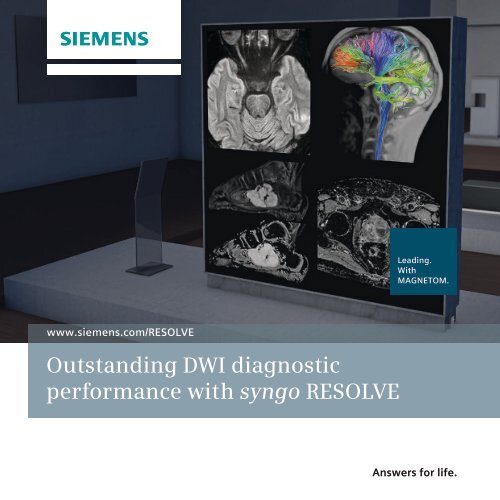

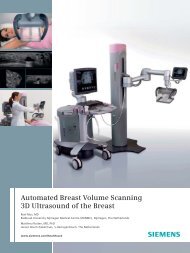
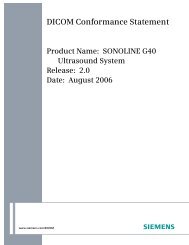
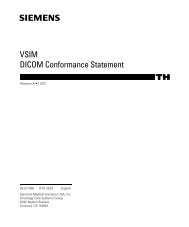

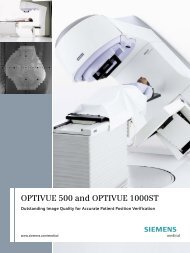
![WalkAway plus Technical Specifications [41 KB] - Siemens Healthcare](https://img.yumpu.com/51018135/1/190x253/walkaway-plus-technical-specifications-41-kb-siemens-healthcare.jpg?quality=85)
